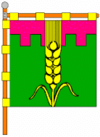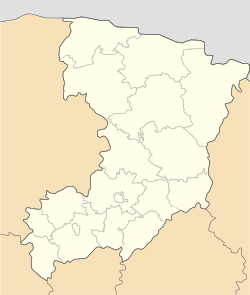Demydivka
Demydivka (Ukrainian: Демидівка, Polish: Demidówka) is an urban-type settlement in Rivne Oblast of Ukraine. It is the administrative center of Demydivka Raion. The settlement is located 40 km from the railway station on the Dubno-Krasne-Zdolbuniv line. Population: 2,572 (2017 est.)[1]
Demydivka Демидівка | |
|---|---|
 Flag  Coat of arms | |
 Demydivka  Demydivka | |
| Coordinates: 50°25′00″N 25°20′00″E | |
| Country | Ukraine |
| Oblast | Rivne Oblast |
| Raion | Demydivka Raion |
| Area | |
| • Total | 16.89 km2 (6.52 sq mi) |
| Population (2017) | |
| • Total | 2,572 |
Demydivka is located on both banks of a small Zhabychi River, 80 km from Rivne and 35 km from the Dubno railway station. Yards - 548, population - 3.5 thousand people. Dubliany and Lishnya are subordinated to Demydivka's village council.
History
![]()
![]()
![]()
![]()
![]()
![]()
![]()
![]()
Archaeological findings (stone axes, hammer) indicate that these lands were inhabited in the Bronze Age. Also Roman coins of the 3rd century were found, remains of an ancient city are preserved. In the village Lishnya, which is located at a distance of two kilometers from Demydivka, traces of the ancient ruins of the castle were remained, around which there was a deep ditch that was filled with water. The territory where a castle was situated is called Zamchysko.
The town was first mentioned in 1570. Then it was called Demydiv. At the beginning of 17th century Demydiv was a small village, which belonged to several landlords. In 1629 it consisted of 21 houses.
During the liberation war of 1648–1654 the people of towns and villages along the rivers Stir and Ikva struggled against Polish Noblemen oppression. And now the fields between Demydivka and Berestechko farmers are still ploughing weapon and personal stuff of the Cossacks.
The position of the residents of Demydivka, which was remained under the Poland dominion. After the «eternal peace» in the 1686 the things go even worse. The amount of the serfdom was on the average 5–6 days a week. In addition, farmers had come to "zazhynky", "obzhynky" (kinds of public work), and pay money "chynsh" (special kind of tax). During the 18th century took place a lot of rebellions. Inhabitants of Demydivka also took part in insurrectional movement. In 1702 residents of Demydivka gave a support to the rebels.
The population of Demydivka grown up very slowly. In the 1775 there were around 43 houses. At the time of the census in 1797, there were 679 inhabitants. Demydivka become the town. Part of the inhabitants engaged in handicraft.
In 1795 Demydivka become a part of the Russian State. Till 1860 it was possession of landlords Harchynski. Later it became the property of the State Treasury.
Demydivka's workers had to work hard even after the abolition of serfdom. Each able-bodied person had to cultivate 6 "morgs" (3.5 hectares) of land, that was almost unsuitable for the agricultural use. And farmers had to pay double the real cost for that land. Inhabitants of Demydivka did not suffer just from social oppression. In 1870 and 1873 there were two conflagrations, which burned 76 houses. Only 53 houses remained. Most of victims of the conflagrations was forced to leave their houses and had to seek livelihoods.
Demydivka was being restored very slowly. At the time of the census in 1897 there were 679 inhabitants. It became a town. Part of the inhabitants engaged in handicraft. Private families that lived in Demydivka went bankrupt and had to work at the plants. In the late 19th and early 20th century several small enterprises opened that were rich enough. They were a sawmill and four small factories. Three times a year there was a big fair in Demydivka. The town became alive and crowded.
The revolutionary events of 1905–1907 found repercussions in Demydivka, too. There was rebellion, and conflicts with the police took place. Peasants attacked the officers' houses, shouting, "Bloodsuckers! bribetakers! out with police! get out!". The workers were not frightened with terror during the "Period of reaction".
The cultural level of the town was very low. There were no mail, medical, cultural and educational institutions in Demydivka. Only in 1913 was a school opened, but not all children had the opportunity to study there.
Workers of Demydivka resented enforcement obligations, and the high cost. The situation got worse when in August 1915 the Austro-German troops conquered the western part of the country. In early September 1915, Demydivka was occupied by the Austro-Hungarian troops. The 8th part of the Russian army under General Brusilov on September 10, saved the town.
Since the formation of the Rivne Oblast, Demydivka is one of its regional centers.
During the Soviet-German war in 1941, the raion was occupied by Nazi German troops. During this period, thousands of people were killed. According to the Soviet State Extraordinary Commission, in October 1942, 600 Jews were shot and buried in a pit that had been dug before the shooting.[2]
In 1962, Demydivka Raion was broken up and Demydivka became a part of Mlynivsky raion.
In 1996, Demydivka Raion was renewed. Now there is a school, a hospital, a canning factory and a lot of private enterprises.
References
- "Чисельність наявного населення України (Actual population of Ukraine)" (in Ukrainian). State Statistics Service of Ukraine. Retrieved 26 August 2017.
- "Execution Sites of Jewish Victims Investigated by Yahad-In Unum". Yahad-In Unum Interactive Map. Retrieved 23 January 2015.